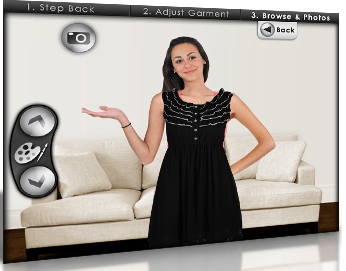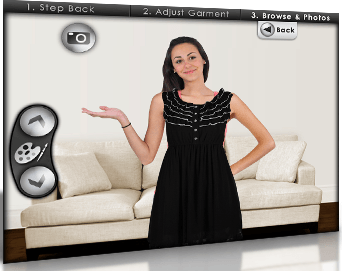
Guest Post: The Good and Bad of Augmented Reality 3D Virtual Fitting Rooms
January 13, 2012 by guest author, Jack Benoff
Have you seen the coverage of these 3D Virtual Fitting Rooms?
Thanks to the power of the Microsoft Kinect several of these hacks products have entered the market over the past few months, and they’re getting a bit of media attention (wait, here’s another one that just launched yet is claiming to be the “first”).
Because of all this coverage, I’ve been asked by a few people for my thoughts on these 3D Virtual Fitting Rooms, hence this post. Hopefully, it will initiate a bit of dialogue among us, and whether you agree or disagree with me, I’d love for you to weigh in with comments.
Here’s what we think:
THE GOOD
Depth Sensing Cameras – The cameras these executions are using are cutting edge and offer (developers) some huge opportunities to create compelling motion/gesture based user interfaces, and overall more sophisticated augmented reality user experiences. A depth sensing camera’s functionality is simply leaps and bounds more advanced than the average person’s webcam… it’s not even close.
To borrow a Larry Miller quote: “It’s the difference between shooting a bullet and throwing it.”
Powerful Hardware Systems – When we’re looking at In-Store 3D Virtual Fitting Rooms, developers are able to control the hardware that’s powering the experience. That means they can create significantly more powerful applications since they don’t need to build software for the hardware the average user has at home (like we do). This is definitely a benefit.
Foot Traffic – These types of systems are pretty novel, and initially people will be interested in playing around with them. So if you’re one of the first stores to utilize the tech, you’ll probably generate a bit of extra foot traffic, and a bit of buzz.
THE BAD
At Home Hardware & Penetration – All of these 3D Virtual Fitting Rooms claim to work in people’s homes. And technically, that’s possible. They can be made to work in a home, but I’m going to get right to the point: do you have a depth sensing camera at home? Probably not. In short, that means you can’t use the 3D Virtual Fitting Room.
The fact is PCs and connected TVs are a few years away from having depth sensing cameras integrated natively, so realistically your only opportunity to have a depth sensing camera at home is to own a Microsoft Kinect. So, let’s assume you have a Microsoft Kinect at home — after all, as of March there were already 10 million units sold.
First off, as we discuss consumer reach, is should be noted that that number pales in comparison to the PC numbers Intel noted recently: over 1 million computers are sold daily and there are 1.5 billion in use.
Second, Microsoft hasn’t announced details around commercial licenses for the Kinect. And that’s important. Will a retailer have to pay 50 grand to create Xbox applications? Will Microsoft take 30% of sales and kill any margins? Will they even allow a third party shopping application on X-Box Live or will they “reject” them when submitted? These are all questions that today we don’t know the answers to.
So, if only a minority of people even have potentially compatible hardware, and those that do have no ability to access the software … how can people realistically use a retailer’s 3D Virtual Fitting Room at home?
Content Is Critical, And There Is No Content – This one will be quick: Manufacturers/Retailers don’t have 3D assets of their clothing items, and as of today 3D assets for augmented reality are cost prohibitive to produce. And without clothes, it’s not a very compelling “fitting room” is it?
“Fit” Just Can’t Be Done – Even if retailers could create perfect-looking 3D assets in a cost-effective manner, these alleged 3D Virtual Fitting Rooms can’t accurately portray fit (i.e. where a garment would actually bunch, hang, or bulge on a person’s very unique body), or provide shoppers with the tactile feedback that’s such a key component of the promise of fit.
What’s The Value-Ad For The In-Store Shopper? – Question: What exactly does the spate of 3D Virtual Fitting Rooms add to the current in-store shopping experience? It’s new… and different, sure. But does it truly help the shopper shop?
Once they get past some initial “Wow Factor,” will it continue to add to the shopping experience? I mean, the actual dress is three feet away on a hanger. If they’re at home, I get it. It can help them to better visualize what the item might look like on them.
But why would a shopper that’s in a store prefer to “hold up” a digital dress, rather than feel and interact with the real deal? They made the effort to leave their homes, and come to a store. Why would they then opt for an experience they could pretty much have at home on their laptop?
As I’m sure you can guess, in my opinion the “bad” outweighs the “good” for today’s crop of 3D Virtual Fitting Rooms. The technology is incredibly powerful but I think that the realities of the current marketplace make this technology an unwise investment for retailers.
To be honest, if a retailer has the luxury of being on a development timeline that lasts a few years and can afford some R&D, then my advice would change. But with budgets being tight, if a retailer wants to make an impact today, I think it’s way more prudent for them to start with a 2D experience online. It’ll cost less; will be easier to produce/execute; will be usable by significantly more of their shoppers; and, already has data to support its effectiveness.
This post originally appeared on Zugara’s We Are Organized Chaos blog





Leave a comment